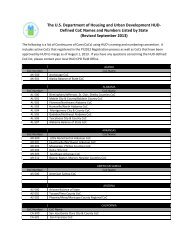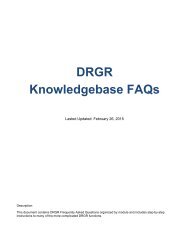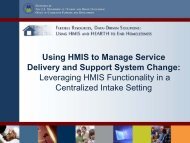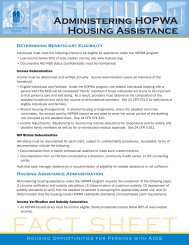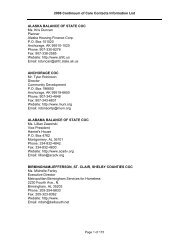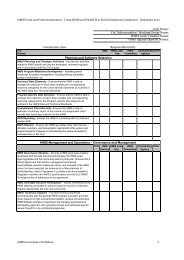HMIS Project Management Topics and Tools - OneCPD
HMIS Project Management Topics and Tools - OneCPD
HMIS Project Management Topics and Tools - OneCPD
- No tags were found...
Create successful ePaper yourself
Turn your PDF publications into a flip-book with our unique Google optimized e-Paper software.
<strong>HMIS</strong> <strong>Project</strong> <strong>Management</strong> <strong>Topics</strong> <strong>and</strong> <strong>Tools</strong>Data <strong>Management</strong>The system administrator is often involved in the cleaning of data, monitoring data quality,seeking out <strong>and</strong> resolving duplicate records, creating datasets of unduplicated clients, <strong>and</strong>generating aggregate reports (sometimes in partnership with data analysts). The systemadministrator is also primarily responsible for overseeing local data integration efforts. A list ofresources related to many of these complex topics can be found in Appendix 1.Technical SupportTechnical support is a crucial aspect of any <strong>HMIS</strong> implementation. No matter how simple <strong>and</strong>user-friendly a system may be, there are bound to be questions. A technical support person maybe used in medium or large implementations as the primary liaison to the end users for help withsoftware bugs, assists with trainings, <strong>and</strong> provide assistance with generating reports, data entry<strong>and</strong> sharing. The technical support person tracks “Help Desk” issues <strong>and</strong> software bugs, testsupgrades, works closely with site staff <strong>and</strong> end users, <strong>and</strong> reports to the system administrator<strong>and</strong>/or project manager who reports bugs <strong>and</strong> software wish lists to the software solutionprovider or local programmer. Ideally, technical support staff will have a human servicebackground so that they can relate to the end users, recognize difficulties <strong>and</strong> challenges thatthey may be facing <strong>and</strong> work with them on realistic <strong>and</strong> creative solutions.Technical Support TypesThe project manager will need to decide upon the most cost effective <strong>and</strong> efficient technicalassistance delivery plan. The project manager may choose one type listed below or may selectseveral of these. If she or he selects several, the technical support staff will need very clearguidance about when <strong>and</strong> under what circumstances to use each type. For example, if the projectmanager decides to implement both phone <strong>and</strong> in-person technical assistance, the staff will needto know when it is appropriate to visit agencies as opposed to fielding questions over the phone.The appropriate process for accessing technical support should be documented in a technicalsupport policy that formally identifies the escalation process during <strong>and</strong> after business hours.These policies should be communicated to all users during training.• Paper <strong>and</strong> on-line documentation. Most <strong>HMIS</strong> solutions will have paper <strong>and</strong>/or on-linedocumentation. Each user should have access to this documentation as well as trainingmaterials <strong>and</strong> should be trained to look up questions in available resources prior toaccessing technical support. The project manager may want to develop supplemental“how to” resources that outline step-by-step procedures for completing common tasks. Aswell, the project manager may want to consider disseminating “Frequently AskedQuestions” (FAQs) or other tips to help communicate solutions to common software oruser issues.11




